Learning how to setup a gymnastics gym is simple. There are just two steps. First, you need to learn the standard recommendations for each apparatus. Then you need to adapt your space to meet those standards.
This may mean adjusting your current plan or even removing a piece of equipment. That may not be convenient, but caregivers will always appreciate your efforts to ensure a safe experience for their children.
In this blog we outline the standards for each apparatus as put forth by the International Gymnastics Federation (FIG), whenever applicable. We’ll also provide additional tips on recreational gymnastics adjustments, preschool gym space, party rooms, lockers, and more.
About the Author: This article was written with input from across the Uplifter team. Uplifter’s gymnastics software supports hundreds of gymnastics clubs and major gymnastics federations and associations across North America. The quality of our software and support has earned us exclusive partnerships as the only gymnastics software partner of Gymnastics Ontario, Gymnastics BC, Alberta Gymnastics Federation, Manitoba Gymnastics Association, and more.
In this article, we leverage our experiences, conversations, and research to provide you with a resource that you can use to help determine how to setup a gymnastics gym.
Let’s get started.
How high should a gymnastics beam be?
The International Gymnastics Federation (FIG), uses a balance beam that is 1.25 meters (4.1 feet) tall, 10 centimeters (4 inches) wide, and 5 meters (16.4 feet) long. However, these are simply the dimensions for a beam used in competition.
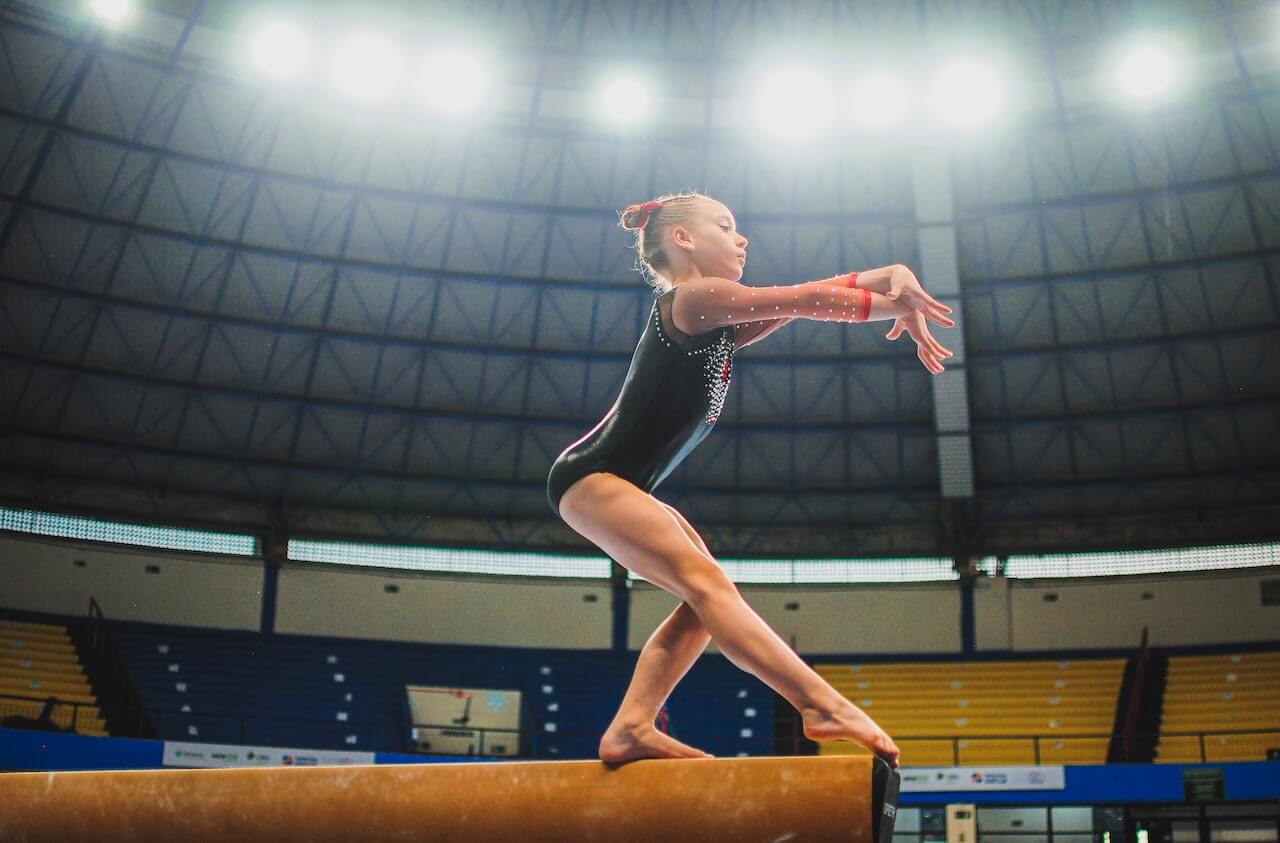
When determining how to setup a gymnastics gym for recreation and competitive training, you may choose to use several different beams.
The first type of training beam is a low profile beam that lies flat on the ground. It can even be replaced by a simple strip of tape or Velcro on a floor mat. This will allow gymnasts to try new skills without the consequence of falling off a competition beam.
Beyond this, there are additional training beams that differ in width, height and length.
You may choose to include a variety of beams at your gym as a way to help gymnasts graduate to a competition beam over time.
Tip: If your gym inherits or purchases a wooden beam, consider buying additional beam padding that can wrap around and attach to it with Velcro. This will allow kids to practice movements such as front and back rolls on softer padding. The last thing you want is a young gymnast forgetting how to properly tuck their head and flopping flat on their back on a hard wooden beam!
How do you setup gymnastics rings?
According to FIG, gymnastics rings should have an inner diameter of 18 centimeters (7 inches) and hang 50 centimeters (19.7 inches) apart. They should also hang 3 meters (9.8 feet) from their point of attachment to the lower, inner side of the rings.
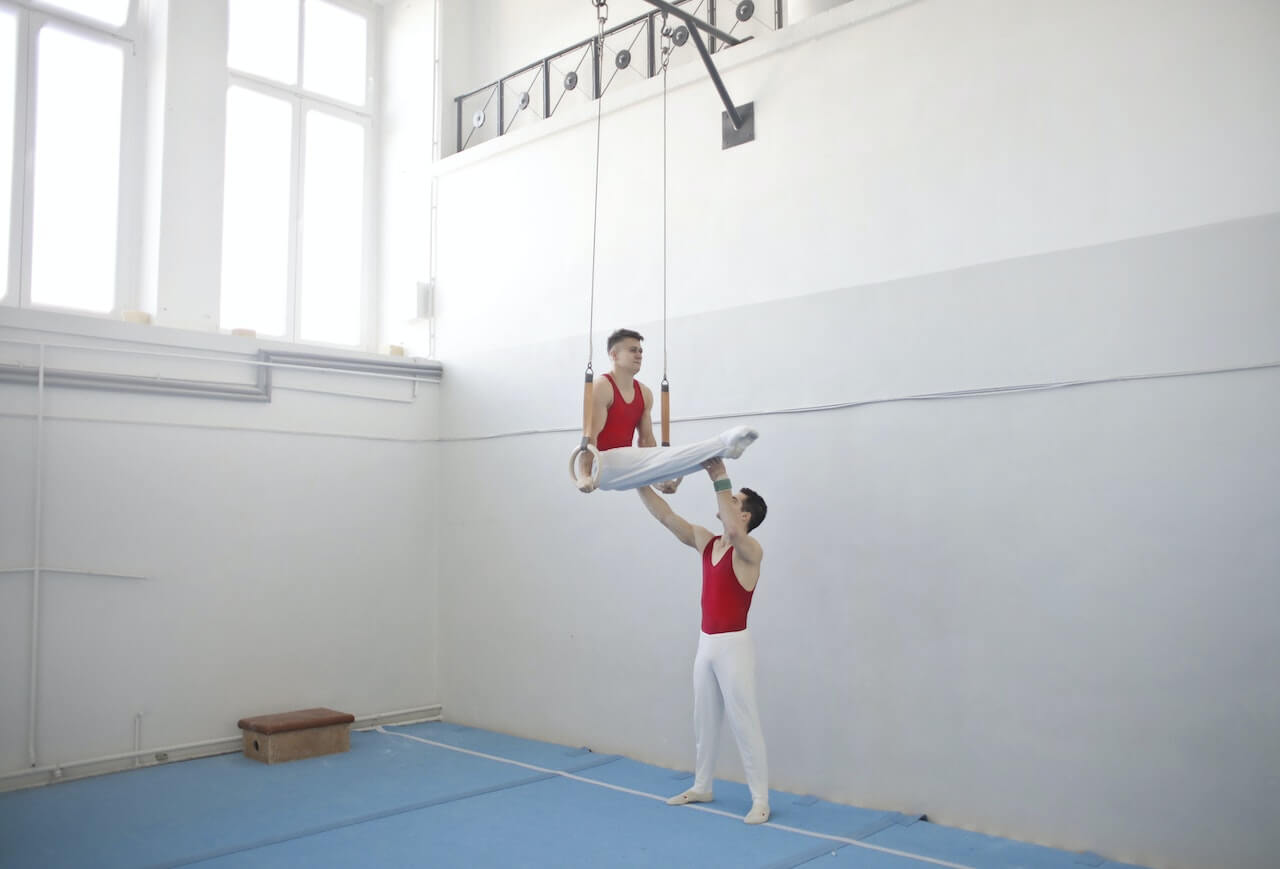
Tip: Good, safe padding below the rings is just as important as the rings themselves. When training any inverted movements, it’s prudent to have a thick crash mat beneath the rings whether the athlete is recreational or competitive. Although coaches will be there to spot the athlete, it’s always good to have an extra layer of safety.
How do you setup a pommel horse?
The FIG states that the pommel horse should be 1.15 meters (3.7 feet) tall, 1.6 meters (5.2 feet) wide, and 35 centimeters (13.7 inches) deep on it’s top, while measuring 30 centimeters (11.8 inches) deep on its underside. The pommel horse handles must be 40 to 45 centimeters (15.7 to 17.7 inches) apart.
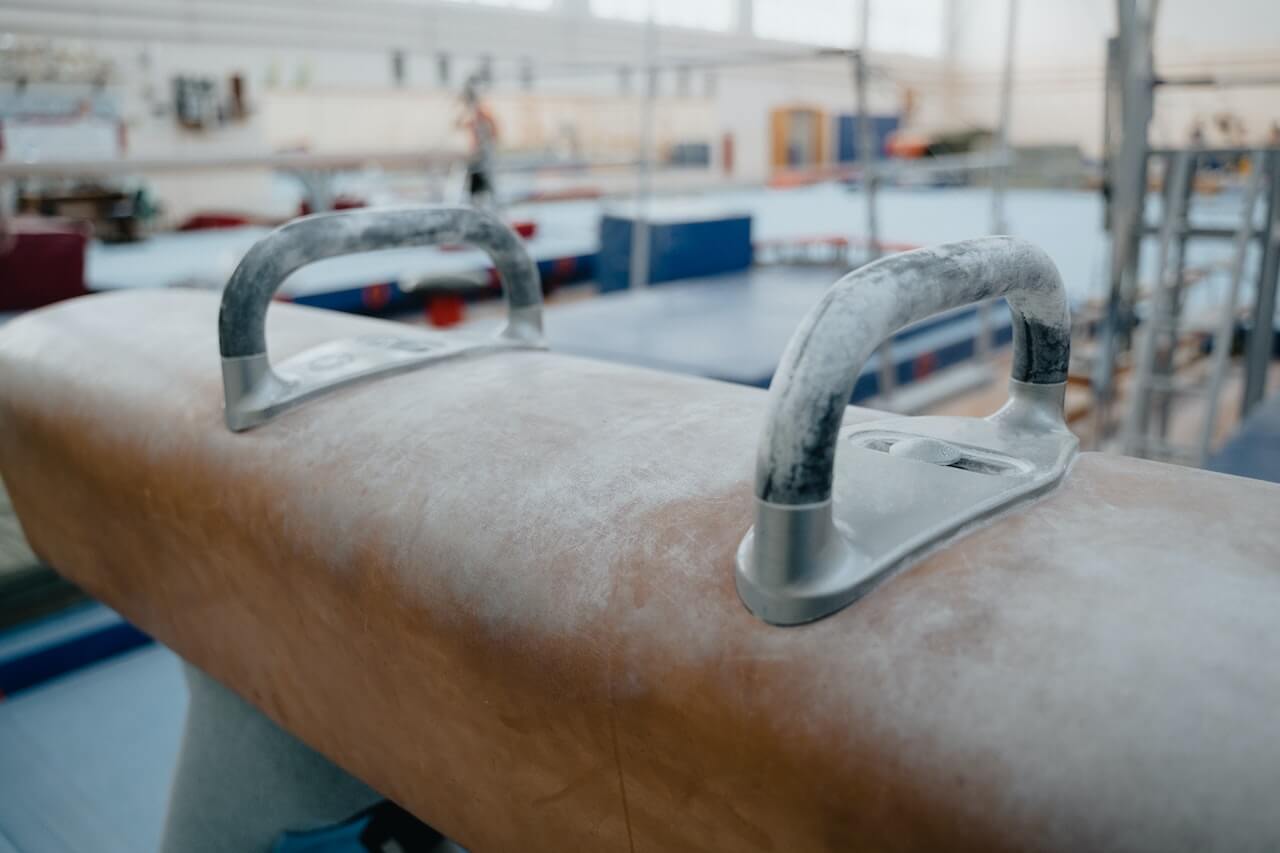
Unlike many apparatuses that require 20 centimeter (7.9 inch) thick padding around them, the pommel horse only requires 10 centimeter (3.9 inch) thick padding surrounding it, according to FIG.
How deep should a foam pit be?
There doesn’t seem to be a rigid standard for foam pit dimensions. Some recommendations are as shallow as 0.91 to 1.5 meters (3 to 5 feet) while others are deeper. If you’re starting from scratch, it may be best to aim for 1.8 to 2.4 meters (6 to 8 feet), according to gympit foam in the United Kingdom. Ultimately, you want to ensure your gymnasts can fall from a height and be safely cushioned in your foam pit, so good depth is required.
Of course, foam pits also require safety mats around the pit edging, foam cubes inside the pit, a trampoline bed at the bottom, and foam pylons beneath that.
Which apparatus should lead to the foam pit?
It’s common for gyms to have multiple apparatus leading to a foam pit. These can include vault, horizontal bar, floor, and tumble track, among others.
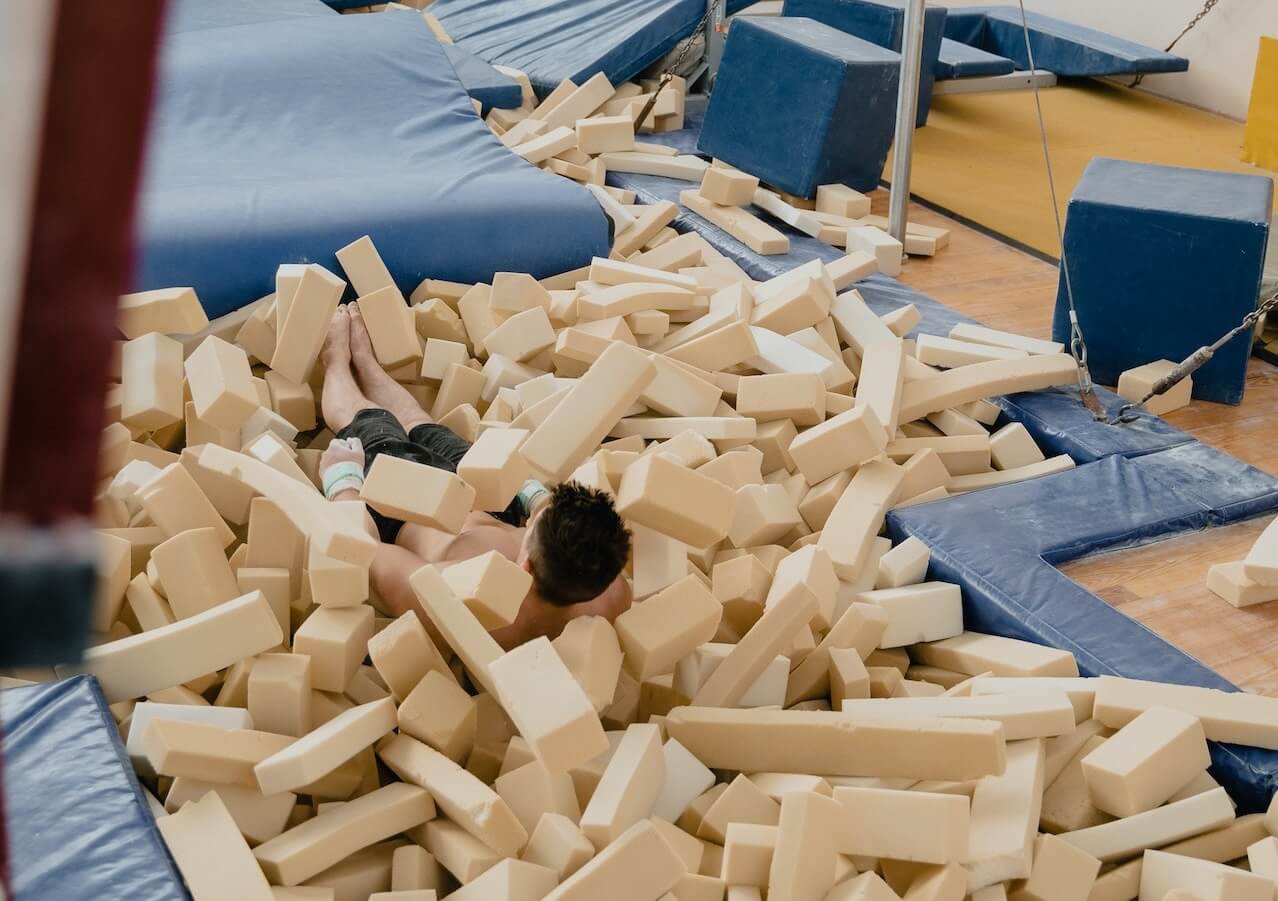
When you have several apparatuses leading to the foam pit, coaches must be in communication about which apparatus is using the foam pit in order to avoid collisions.
Tip: Foam pits are one of the hardest apparatuses to clean in the gym, so you’ll need to schedule proper cleanings. A proper cleaning includes completely emptying the foam pit of all its foam blocks, cleaning the pit itself and then all of the individual blocks. This takes time. Consider assigning multiple coaches to help clean the pit either before or after class.
Note: Just like all other apparatus and elements of construction in your gym, it’s always advised to have your legal team review and provide any necessary guidance on foam pit decisions.
How high should a vault be?
Much like the beam, there can be a big difference between the vault used in competition and in training.
For recreation and competitive training, gymnasts can practice on a training vault. These vaults are made of softer foam and often come in multiple sections. This allows coaches to adjust the height of the vault to match the abilities of different gymnasts. Here are two examples of adjustable training vaults from Spieth and Sport Direct (no affiliation).
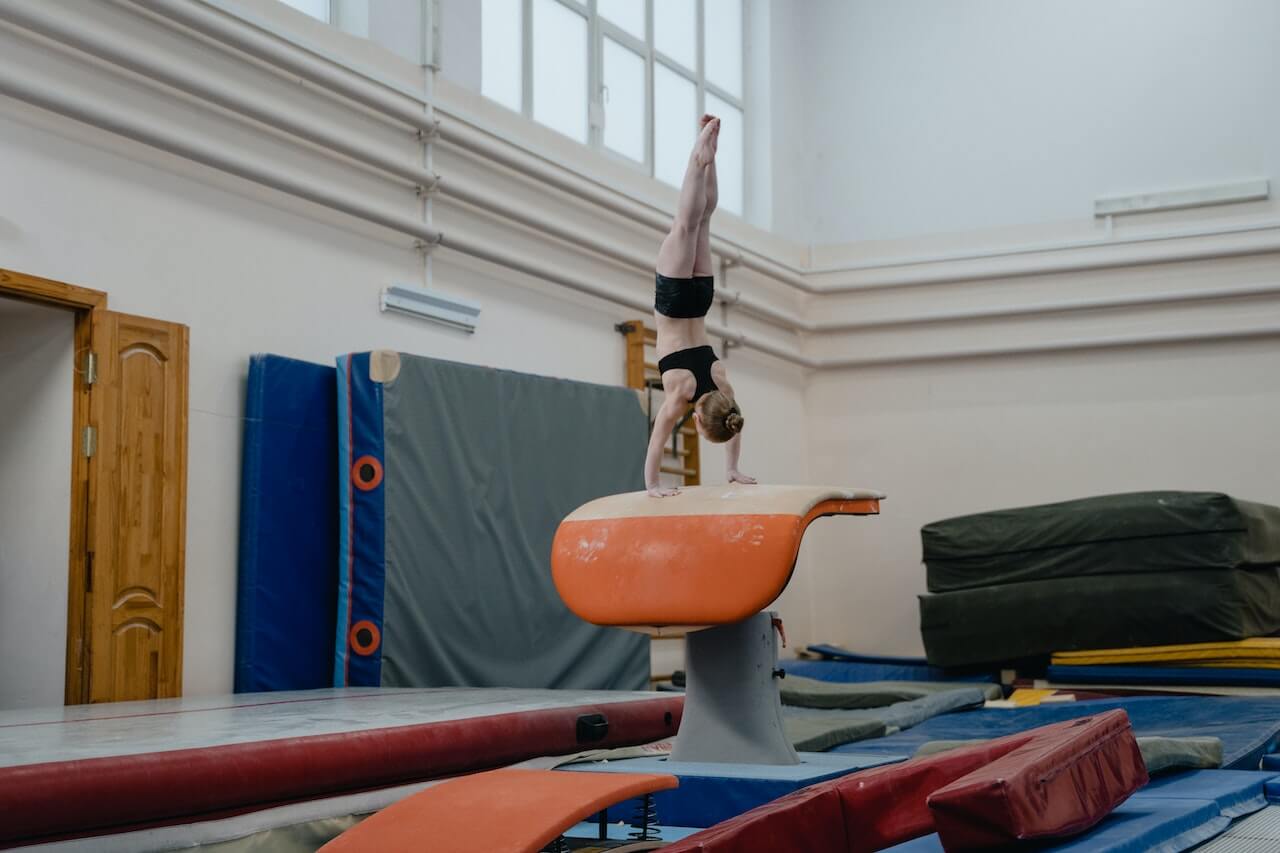
For official competition, FIG requires a vault with a length of 1.2 meters (3.9 feet), width of 0.95 meters (3.1 feet) and height of 1.35 meters (4.4 feet). The runway leading to the vault should be 1 meter (3.3 feet) wide and 25 meters long (82 feet).
The spring board should be 120 centimeters (3.9 feet) long and 20 centimeters (7.8 inches) high. The spring board must also have a slip resistant surface and must not slide on impact.
How to setup gymnastics gym floor area?
When determining how to setup a gymnastics gym, the floor area can often vary based on space available. However, the closer you can get to the FIG standards, the better. We say this because a larger floor area will allow your gymnasts to join their skills in tumbling lines.
The smaller the floor area, the more gymnasts have to limit their tumbling lines.
FIG requires the floor performance area to be 12 meters by 12 meters (39.3 feet by 39.3 feet). This means the standard distance from one corner to the opposite corner is 16.97 meters (55.4 feet). In competition, the floor performance area is also surrounded with a 1 meter (3.3 feet) border of mats for safety.
How high is the horizontal bar in gymnastics?
The horizontal bar is an apparatus exclusive to men’s artistic gymnastics. The bar should be set at 2.75 meters (9 feet) high and run 2.4 meters (7.9 feet) long.
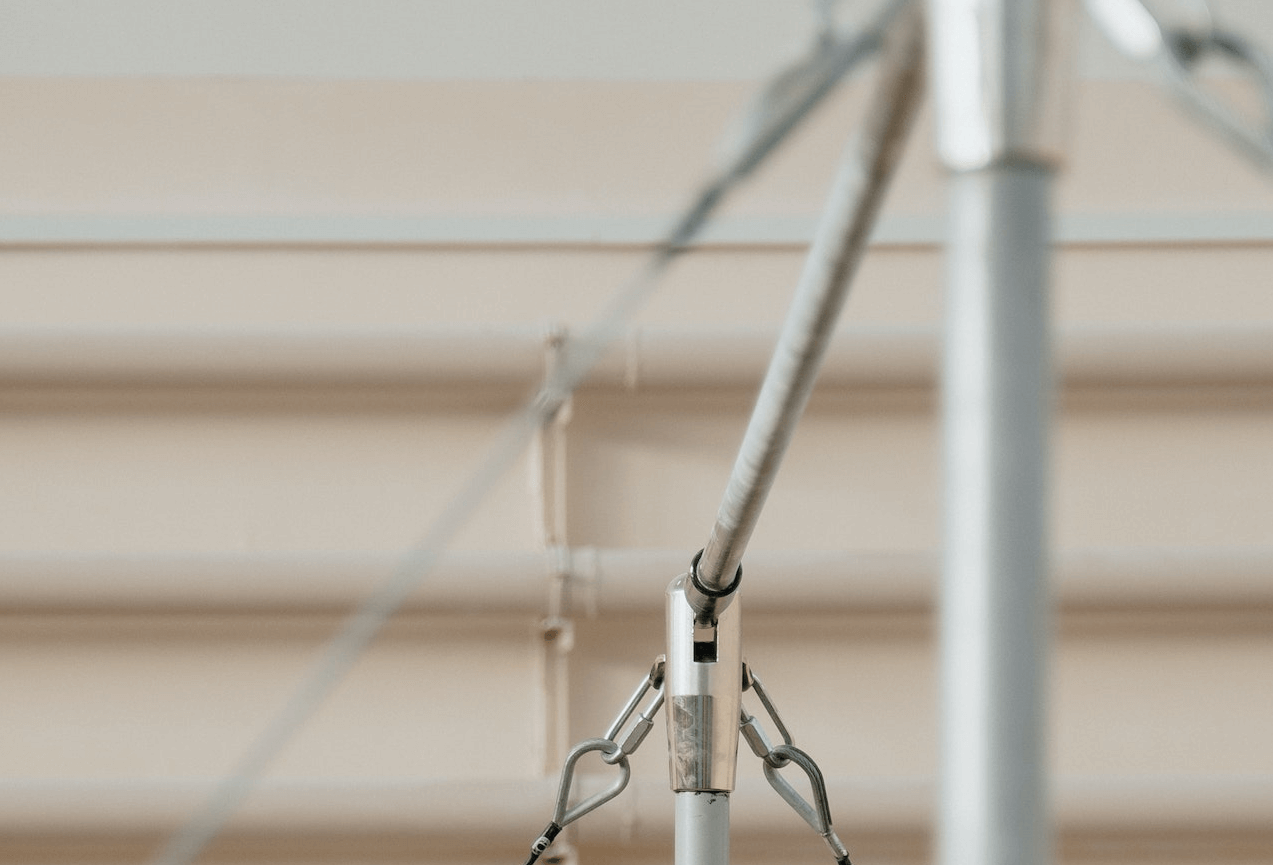
How high should gymnastics uneven bars be?
The uneven bars are an apparatus that is exclusive to women’s artistic gymnastics. The height of the upper bar is 2.55 meters (8.4 feet) from the ground. The height of the lower bar is 1.75 meters (5.7 feet) from the ground.
Both bars can be raised by 5 centimeters (2 inches) to accommodate taller gymnasts, and both should be 2.4 meters (7.9 feet) in length.
Lastly, the diagonal distance between the bars should be 1.3 to 1.81 meters (4.3 to 5.9 feet). Further details can be found in FIG’s apparatus guide.
How high should parallel bars be?
Much like the horizontal bar, the parallel bars are exclusive to men’s artistic gymnastics. The parallel bars should be 2 meters (6.5 feet) high and 3.5 meters (11.5 feet) long. They can be set between 42 and 52 centimeters (16.5 and 20.5 inches) apart, adjusted to suit the gymnast.
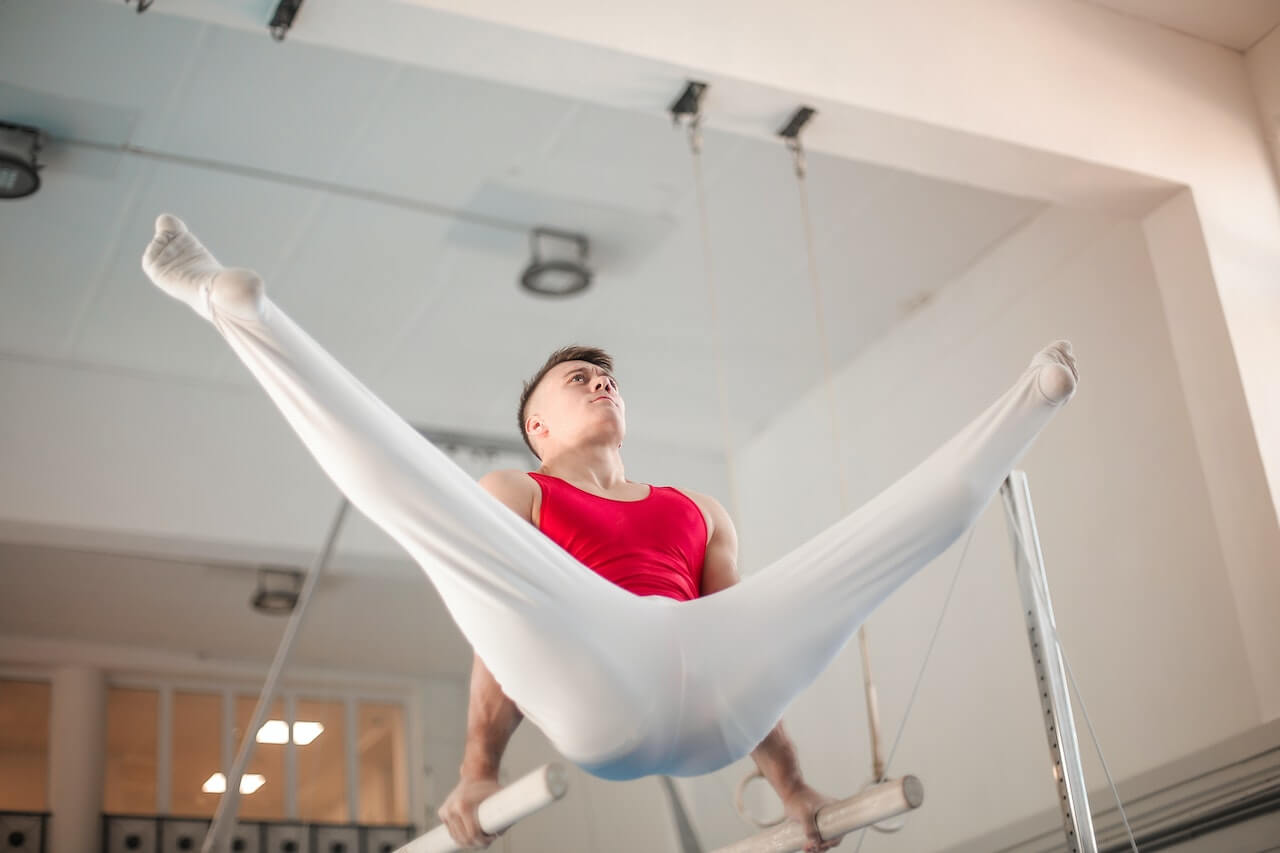
How long should a tumble track be?
Determining the length of your tumble track is similar to determining your floor dimensions. In both cases, gyms can be limited by their building’s available space.
If you’re hesitant about fitting a tumble track in your space, consider whether or not your gymnasts will have enough space to link their tumbling skills into a tumbling line.
Even if you’re not able to fit a competition length track in your gym, many suppliers sell shorter tumble tracks that might fit.
FIG requires competition tumbling tracks to be 25 meters (82 feet) long and 2 meters (6.5 feet) wide. The track also requires a landing mat 6 meters (19.7 feet) long by 3 meters (9.8 feet) wide and 30 centimeters (11.8 inches) thick.
Remember, competitive gymnasts also need a runway leading into the tumble track. USA Gymnastics lists their recommended runway at 10 meters (33 feet).
How do you setup a gymnastics trampoline?
Each gymnastics apparatus requires thorough safety planning, and this fact is perhaps most true for the trampoline. First and foremost, you must ensure your facility’s ceiling is high enough for a gymnast to reach their maximal height while maintaining a comfortable distance from the ceiling.
Beyond jump clearance, the trampoline must also be free of obstruction beneath the trampoline bed.
According to FIG, the trampoline frame should be approximately 5.05 meters (16.5 feet) long by 2.91 meters (9.5 feet) wide and 1.15 meters (3.77 feet) high. When under tension, the trampoline bed should be approximately 4.28 meters (14 feet) long by 2.14 meters (7 feet) wide.
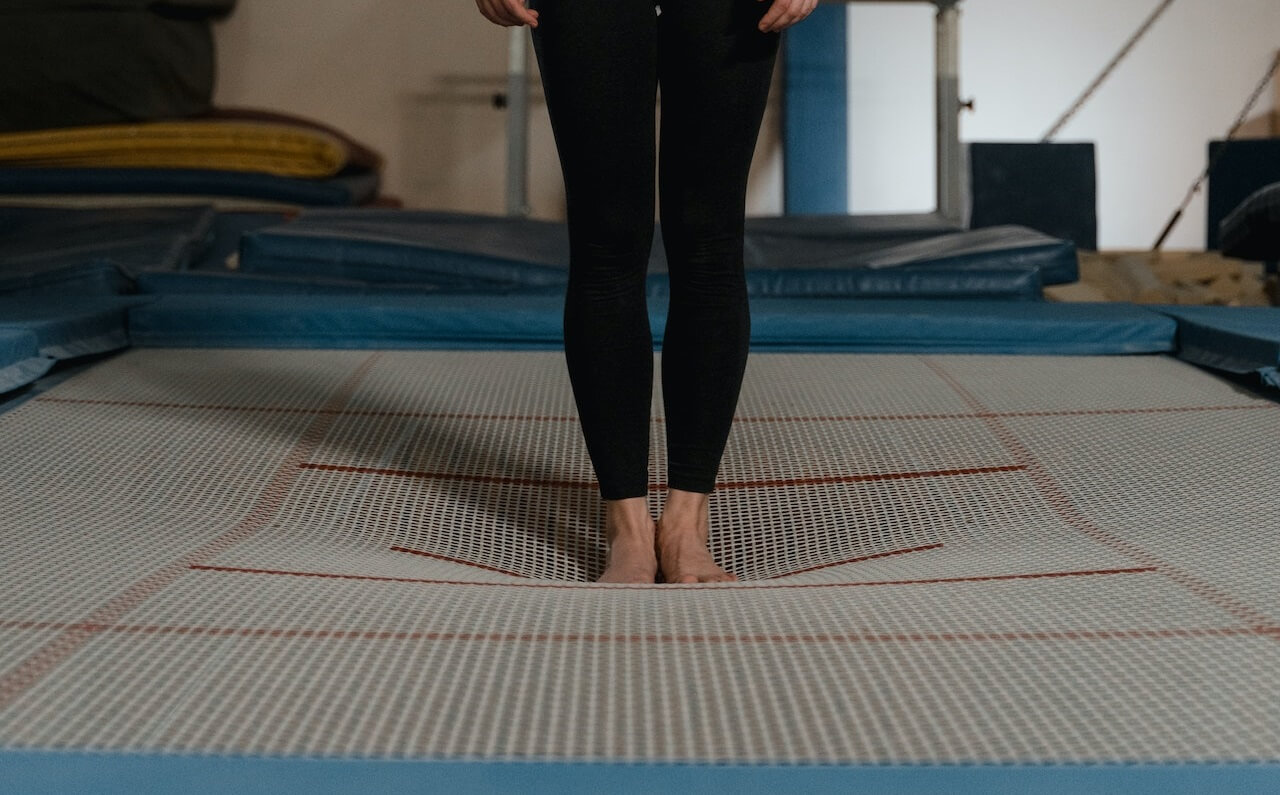
For additional guidance on padding, string and web distance, see FIG’s guidelines.
How big should a preschool gymnastics space be?
We’ve already written a deep dive on the benefits of offering preschool gymnastics at your gym. It also allows young parents and caregivers to get out of the house and engage in physical and mentally stimulating play for their little ones and themselves.
A positive preschool gymnastics experience can help your gym earn long-term customers for years to come. For this reason, it’s important to provide enough space to deliver fun, engaging and memorable programming.
Of course, your preschool gymnastics can be offered in the same space as your regular programming, but be sure to incorporate equipment specifically tailored to a toddler’s abilities. And, as we wrote about in the above linked article, make sure your preschool gymnastics equipment is unique, not something that parents can easily buy online.
What if my facility has support columns?
Many gymnastics clubs and schools are setup in industrial buildings. Sometimes these buildings have support columns in the middle of their space. These columns are there to support the buildings ceiling, however, without proper planning they can get in the way of your apparatus.
It’s extremely important to setup your apparatus so that columns are not obstacles that a gymnast must work around. It can be extremely dangerous if a column interferes with the safe working space of any apparatus.
Columns should be positioned between apparatus and all columns must be wrapped with appropriate safety padding.
How to setup a gymnastic gym parent viewing area?
The parent viewing area should be large enough for a class of parents to comfortably wait for their children. This means if you have 30 kids in your gym at a time, your parent viewing area should be large enough to fit 30 parents (or one parent per child).
Of course, not every parent will get a window seat, but they should be able to hang out at your gym for the duration of their child’s class. Some parents will simply drop off their children and return at the end of class to pick them up. But, ideally, your facility should still have the option for parents and caregivers to comfortably stay. A tiny and cramped parent viewing area can poorly reflect on your brand and gym experience.
Does a gymnastics gym need lockers?
No, a gymnastics gym does not need lockers. However, your gym should have a private designated space where a gymnast can change their clothes if they need to.
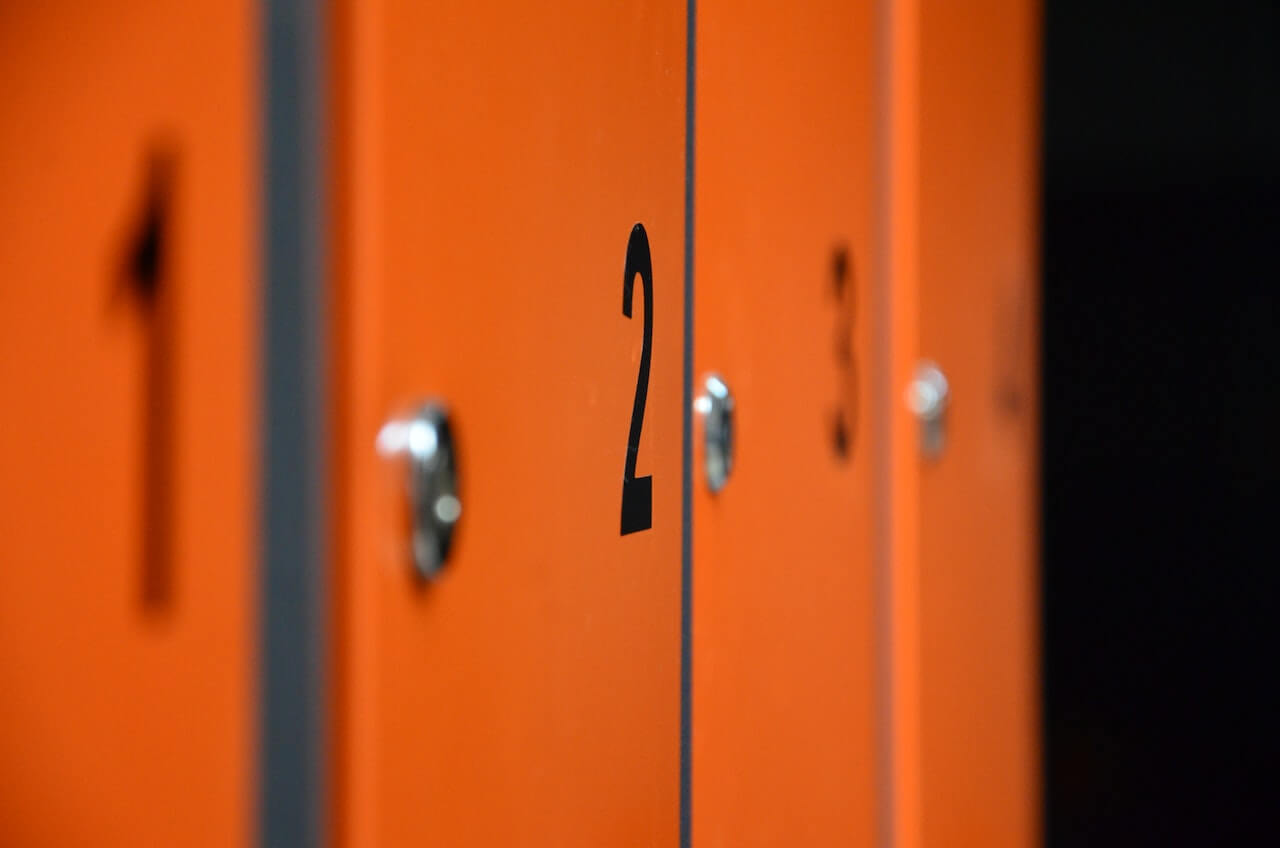
You will also need a space where gymnasts can store their clothing and bags. This bag storage area can be set up without lockers, as long as it’s neat and secure. It’s important to understand that the tidiness of your gym will impact your brand and how customers feel about your business.
Does a gymnastics gym need a party room?
If your gymnastics club is going to host birthday parties, it’s a good idea to have a designated party space.
This may not necessarily mean having a separate room, but there needs to be a clearly defined space where party attendees can store their bags, coats and presents. Most importantly there needs to be plenty of seating and table space for attendees to eat their meal and enjoy some cake!
How to manage registration, waivers, invoicing, attendance, website, emails, evaluations, and financial reporting?
There is a lot to figure out after you determine how to setup your gymnastics gym. At Uplifter, our team is made up of people who have built youth sports clubs, served on volunteer boards, coached in gyms, and of course, registered our own kids for youth sports. We know how important it is to get the right software with the right tools.
With Uplifter’s software you can:
- Enjoy user-friendly online registration that’s been continually optimized by hundreds of gymnastics clubs for the past decade
- Collect signed digital waivers during registration and have them date-stamped and archived directly to a participant’s profile
- Take advantage of automated invoicing with multiple payment options and automated overdue payment notifications
- Record digital attendance on the mat using a tablet/smartphone, or at your front desk using a desktop computer
- Get a mobile-friendly website with built-in SEO tools (it’s easy to manage and hosting is included in your monthly plan).
- Send targeted emails to specific members, classes, or your entire membership using our easy-to-use email tool
- Complete gymnast evaluations in class and send report cards to a member’s participant profile
- Get a 360 degree view on your gymnastics club with 30+ built-in membership and financial reports
Of course, there’s much more included with Uplifter. Want to learn more?
Book a demo today and get the full tour!








